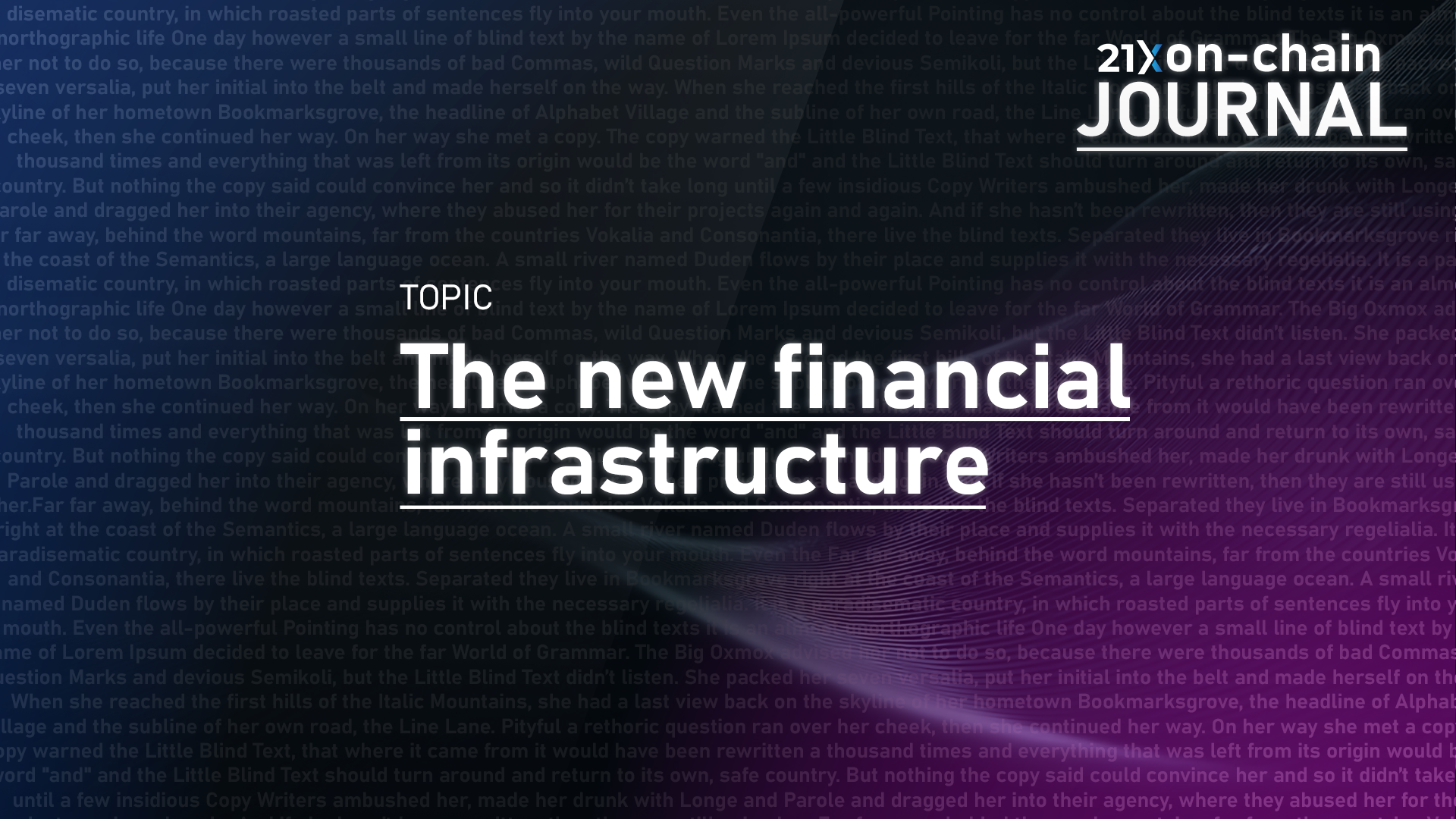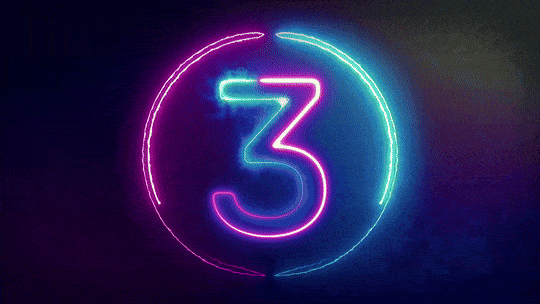Entering the next phase of the internet – the internet of value
by Severin Kranz Head of Business Development @21X
A paradigm shift in global finance has taken over the past 18 months. Driven by unprecedented institutional acceptance and technological maturity, blockchain and the tokenization of assets are no longer experiments or Proof-of-Concepts. With globally leading asset managers, banks and service providers moving on-chain, they are the robust foundation for a fundamentally more efficient, transparent, and accessible era for capital markets. The combination of regulatory clarity and technological innovation is poised to shift the trading and settlement of financial instruments from an analogue into a digital future.
Only a few years ago, the long-term viability of digital assets and their potential to transform traditional finance was the subject of intense debate. Today, that question has been decisively answered. Two pivotal analyses – the Franklin Templeton report, “The compelling case for crypto,” and a16z’s “State of crypto 2025” – paint an unambiguous picture: The next generation of financial infrastructure will be based on Distributed Ledger Technology (DLT), enabling the tokenisation and seamless trading of real-world assets.
The messaging of these two reports is in line with the vision 21X has been pursuing since its foundation in 2022, that capital markets can only make the great leap forward in efficiency, transparency and accessibility if assets – whether tangible or intangible – are tokenized and made available on-chain. The launch of 21X, the world’s first regulated exchange for trading and settlement of tokenized financial instruments fully on-chain, is testament that the industry is ready to embrace this.
From niche to institutional mainstream: digital assets come of age
The era when digital assets meant speculation in crypto currencies by limited numbers of retail traders is now giving way to institutional participation across a growing range of tokenized assets. Franklin Templeton estimates the market capitalisation of digital assets was a staggering $3.3 trillion at the end of 2024 – an all-time high that unequivocally confirms widespread institutional acceptance. While Bitcoin and Ethereum form the backbone of this new market, their underlying DLT technology is increasingly being applied to a broader range of assets.
A16z further corroborates this structural shift, highlighting that the blockchain economy now serves over one billion users globally. Critically, its adoption curve almost exactly follows that of the internet between 1995 and 2005. This signals that we are merely at the beginning of a decades-long wave of adoption, where DLT will underpin diverse financial instruments, including RWAs. For 21X, this robust foundation means that tokenised financial instruments, encompassing real-world assets, are no longer a utopian concept but the logical next evolution of a global financial system already embracing digital transformation.
The ‘Institutional Era’: Fuelled by regulatory clarity
The growing institutionalisation endorsement of digital assets in capital markets has been termed “The Institutional Era” by Franklin Templeton. This profound shift is fuelled by newfound regulatory clarity and enhanced technological stability, paving the way for mainstream RWA tokenisation.
The approval of spot Bitcoin and Ethereum ETPs in the US in 2024, that led to record inflows exceeding $35 billion, represents more than just crypto exposure. It signifies a crucial step in familiarising traditional institutions with DLT-based investment vehicles. Furthermore, a16z reveals that on-chain stablecoin trading volumes surpassed $1.5 trillion in monthly transactions by the end of 2024. This demonstrates that institutions, funds, and corporations are already leveraging blockchain as an operational settlement layer for significant real-world value transfers.
The message is clear: Digital assets are no longer operating on the periphery, but are becoming the core of the new financial system, creating an imperative for RWA integration. This is powerfully underscored by the fact that the total value of tokenised real-world assets (excluding stablecoins) has already surged to over $35 billion (source: rwa.xyz), showing exponential growth since early 2022. The presence of global financial giants like BlackRock,Franklin Templeton and WisdomTree among the top issuers of tokenised real-world assets (source: rwa.xyz) is an unequivocal signal that these institutions are not just observers, but active drivers of the RWA revolution.
For 21X, this market evolution provides compelling evidence of the need for a regulated DLT market infrastructure any why it was such an early market participant with the launch of its exchange. As institutional players increasingly seek both direct and indirect DLT exposure, their ultimate move will be to trade tokenised real-world securities on the blockchain and manage their investments through smart contracts and stablecoins – demanding an environment that is regulated, secure, and transparent.
The Logical Transition: From ETPs to Native RWA Tokenisation
While exchange-traded products (ETPs) have democratised access to digital asset classes, they often still represent these assets within traditional, often inefficient, structures. The next, inevitable step is native tokenisation, with financial instruments, including a vast array of real-world assets, directly created, traded, and settled on the blockchain. This eliminates redundant intermediaries, manual post-trade processing, and complex clearing hurdles, unlocking unprecedented efficiency for RWAs with cost savings between . The over $30 billion in tokenised RWAs (source: rwa.xyz) already on-chain encompasses a growing diversity of asset types, from corporate bonds, government debt, and stocks to institutional alternative funds, commodities, and private credit – underscoring the broad applicability of DLT.
This vision forms the bedrock upon which 21X is built. As a MiFID-regulated, DLT-native market infrastructure, 21X delivers exactly this capability: issuance, trading, and settlement of tokenised securities within a single system – fully digital and legally compliant. What Franklin Templeton highlights as a powerful macroeconomic opportunity, 21X has translated into a concrete, operational solution. Meanwhile, the move from traditional ETPs to a natively digital capital market, fundamentally enabled by RWA tokenisation, is in full swing.
Technological maturity and demographic changes: Fueling RWA demand
A16z provides the essential technological underpinnings for institutional trust and scalable integration of RWAs. Their research indicates that the underlying DLT infrastructure is no longer experimental but robustly productive:
- The number of active developers in the Web3 ecosystem increased by over 30% in the past year.
- Layer 2 transactions now vastly exceed the Ethereum mainnet, demonstrating scalability.
- Smart contract activity continues to grow – up over 40% in the last year alone.
- The most active blockchains for RWA tokenisation include Ethereum, ZkSync Era, and Polygon, indicating a robust and diversified ecosystem (source: rwa.xyz).
Franklin Templeton underscores this technological shift, noting that Ethereum has already generated over $10 billion in network revenue, outpacing tech giants like Meta, Zoom, or Microsoft in their early years.
The readiness of blockchain infrastructures, combined with the touchpoints for trading, is imperative to meet the demand that will be created as a result of the changing face of market participants. Franklin Templeton reveals that 94% of crypto investors are between 18 and 40 years old. This digitally native generation, set to inherit over $60 trillion in wealth by 2045, expects capital markets that are digital-first, 24/7 tradable, and transparent. This represents not just a target group for 21X but defines the new standard for how financial markets, including those for RWAs, must operate.
Europe’s strategic opportunity: Leading the RWA revolution
Greater regulation is transforming the underlying blockchain technology and blockchain-enabled exchanges from pioneering but uncertain tools into cornerstones for a trusted, enterprise-grade infrastructure that will power the future of capital markets. The outcome is:
- Increased investor trust, making tokenized securities of increased interest to traditional institutional investors and the broader market. This can lead to deeper pools of capital.
- Reduced ambiguity for issuers concerning the tokenized securities’ nature, rights, and protections. The result is greater participation.
- Standardization and governance, which encourage the development of common technical and operational standards, improving market efficiency, reduces operational risk, and facilitates interoperability across different platforms.
While the US and Asia are making significant regulatory strides, Europe possesses a decisive advantage – it is the first major jurisdiction to establish comprehensive legal certainty for digital assets and DLT-based markets through MiCA and the DLT Pilot Regime.
It is on this foundational legal clarity that 21X has built the first fully regulated DLT market infrastructure in the EU. This platform empowers issuers, investors, and intermediaries to trade and settle tokenised real-world assets in a secure, compliant, and efficient environment.
Conclusion: The future is being built today
The messages from both reports are clear:
- Franklin Templeton: “Digital assets and blockchains are here to stay.”
- a16z: “We are entering the next phase of the internet – the internet of value.”
Both perspectives converge on a single truth, that financial markets can no longer operate on existing systems that are slow, inefficient and expensive. Instead, they are being fundamentally rebuilt on new, DLT-native infrastructures specifically designed to integrate and optimise the value of real-world assets.
21X has been developed through thedemands of financial market regulation in concert with the innovative power of blockchain technology. This powerful combination is now translating into global institutional demand for scalable operational solutions for the tokenisation of real-world assets.
The new face of capital markets is here. It is digital. It is integrating real-world assets. And it operates today on 21X.
🔗 Franklin Templeton “The compelling case for crypto”:
https://www.franklintempleton.com/forms-literature/download/DA-CFCB
🔗 a16z “State of Crypto 2025”:
https://d2hguprl3w2sje.cloudfront.net/uploads/2025/10/State-of-Crypto-2025-a16z-crypto.pdf
– end –



